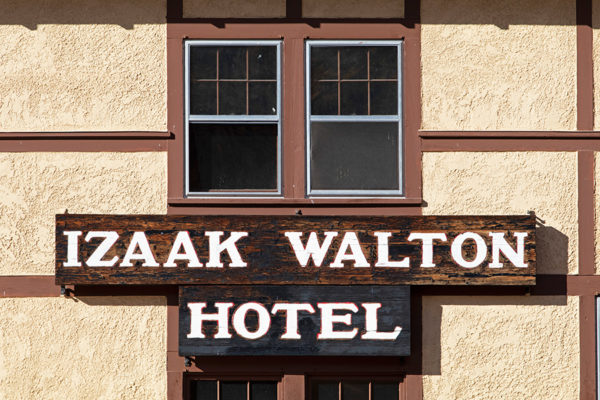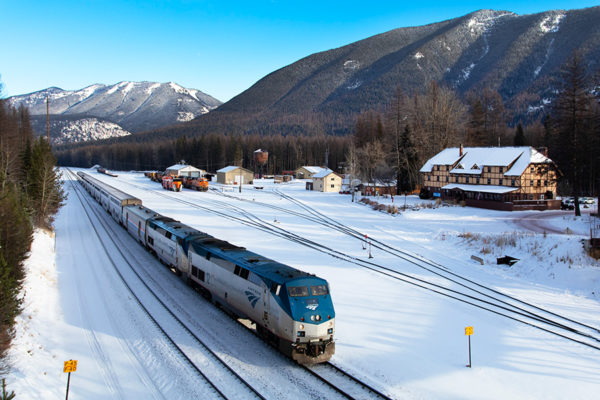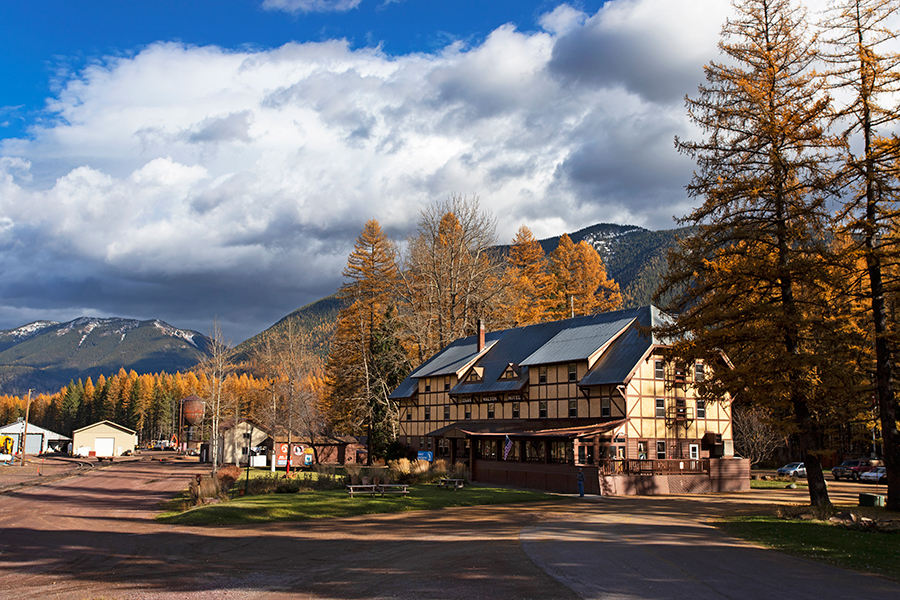Drive east on U.S. Highway 2 along the southern edge of Glacier National Park, take a right at the only turn into Essex, go down the snow-covered road, park your car and get out. The first thing you’ll notice is how quiet it is — unless, of course, there’s a train roaring by on its way toward Marias Pass.
At the end of the road sits the rustic yet regal Izaak Walton Inn, an old railroad lodge turned resort that has served as the heart of this quiet little community for eight decades.
“People pull off the highway and they just say, ‘Wow,’” says Cristinna Gebbia, general manager of the Izaak Walton Companies. “It’s just a gem.”
Today, the Izaak Walton Inn is known as a year-round destination for visitors to Northwest Montana hoping to explore Glacier National Park. Despite the park’s growing popularity, the Izaak Walton Inn remains one of the few hotels open year-round near the park. Located halfway between West Glacier and East Glacier Park, the Izaak Walton has even earned a nickname over the years: “the inn between.” Gebbia says unlike the east and west sides of the park — which can be overwhelmed with visitors during the busy summer months — Essex is almost always a quiet oasis.

While hikers, vacationers and cross-country skiers are the primary reason for the inn’s existence today, the passing trains that rumble past the Izaak Walton every day are the reason it was built in the first place.
More than a century ago, railroads were expanding across the West, including in Montana. Among the iron roads building into the Northwest was the Great Northern Railway, owned by legendary businessman James J. Hill. In the late 1880s, when the railroad reached Montana’s Rocky Mountain Front, Hill had a decision to make. He could either purchase the already built Northern Pacific Railroad, which went through Helena and Missoula, or he could build his own route. Hill chose the latter and sent men into the mountains near today’s Glacier National Park to build a railroad up and over Marias Pass. The rails arrived on the west slope of the pass in 1891.
Running trains over a mountain is a complicated and labor-intensive task. Sometimes railroads have to add extra locomotives to move heavy freight trains up steep grades, and during winter they need to run plow trains to clear the route of snow. Because of that, Essex, about 17 miles west of the summit, became a hotbed of activity for the Great Northern in its battle against gravity on Marias Pass.
Dozens of railroaders were based in Essex, and in the early 1900s, a small hotel with a restaurant was built to house and feed them. In 1935, “the beanery,” as the restaurant and hotel was called, burned down. Soon after, the railroad scrounged up old boxcars for its employees to sleep in, and a nearby family started selling food out of their house, but it was far from an ideal solution, even if the railroad bosses thought it was. According to a history of the Izaak Walton written by Jim and Gail Shay Atkinson, local Great Northern managers tried to convince railroad executives back in St. Paul, Minnesota that a new hotel and restaurant needed to be built, but their request fell on deaf ears.
Two years later, men were still sleeping in old boxcars and the railroad was having trouble finding people to work in Essex during winter. In June 1937, Vice President C.O. Jenks wrote a letter to railroad President W.P. Kenney about the challenges, noting, “The difficulty in getting experienced men to go into snow service is increasing each year.”

Finally convinced that the lack of accommodations was a problem, Kenney approved the construction of another hotel and restaurant in Essex. But this one would be larger than the previous one. According to local lore, in the 1930s, Glacier National Park was considering building a new road that would enter near Essex and head up the Park Creek drainage. Thinking that Essex might become a hotbed of tourism, the railroad decided to build a large lodge that could handle additional railroaders in the winter and visitors in the summer.
In early 1939, the railroad signed an agreement with the Addison Miller Company to build a hotel and lunchroom on Great Northern property alongside the rail yard in Essex. It took 12 carpenters three months to complete the inn, which featured 29 rooms across two and a half floors, 10 bathrooms, a lobby, dining room, and kitchen with a two-ton stove. The inn was designed by Thomas McMahon in the Tudor revival style similar to other Great Northern structures around Glacier Park that were intended to evoke the mountains of Europe. In the early years, when the railroad played a major role in promoting the park, it often heralded Glacier as the “American Alps.”
The Izaak Walton Inn opened for business on Nov. 16, 1939. The inn was named for Sir Izaak Walton, a 17th-century sportsman who authored a number of books on flyfishing.
Unfortunately for the inn’s owners, the plans for a new entrance into the park never materialized, and the Izaak Walton often operated in the red. In 1957, the Addison Miller Company sold the Izaak Walton to Ed Wellman for $5,000. The inn changed hands three more times until the 1980s, when it was purchased by Larry and Lynda Veilleux. By then, it was serving fewer railroaders and more tourists who came to Essex looking to escape the hustle and bustle of Glacier’s busier accommodations. It also became a popular destination for railroad enthusiasts who enjoyed the opportunity to stay right next to the train tracks and listen to heavy freight trains climb Marias Pass. Seeing the inn’s popularity among railfans, the Izaak Walton turned some old cabooses into accommodations. Today, eight railroad cabooses and one locomotive have been turned into rooms on the Izaak Walton property.
In 2006, the Veilleux family sold the inn to Brian Kelly, an ironworker and blacksmith from Chicago. Kelly said he was “tired of the rat race” and looking for something different when he and his family moved to Essex to run the Izaak Walton. Kelly says his background as a blacksmith has come in handy over the years of running a remote inn. There’s no cell service in Essex, and the nearest hardware and grocery store is a 45-minute drive — on a good day.
“You’ve got to be capable of solving problems and being independent,” Kelly says.

Kelly also owns two other businesses in the area: the Halfway Hotel just down Highway 2 in Essex and Eddie’s Cafe & Mercantile in Apgar Village. During the summer, the three properties employ upwards of 60 people, but that figure drops down to about two dozen during the winter.
While the Izaak Walton once housed the railroaders needed to keep the Marias Pass line clear, now most of its winter visitors are attracted to the 33 kilometers of groomed cross-country ski trails. This year, the inn upgraded a pair of bridges on the trails, one of a number of improvements that have been made since Kelly took over the business.
Kelly says he and the rest of the staff at the Izaak Walton are proud of their role in maintaining and running the historic inn. Despite owning it for nearly 15 years, Kelly says he never grows tired of the place. He says he wouldn’t trade anything for the peace and quiet the inn offers him and his visitors.
“Not many people can say that they love their job, but I really do feel like I’m one of those lucky people who can say just that,” he says.
For more information, visit IzaakWaltonInn.com.
